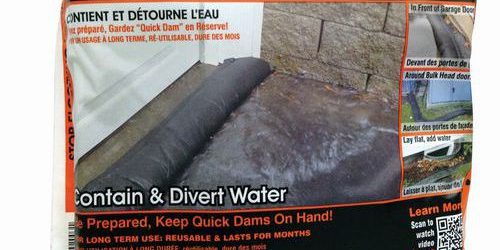Bad weather conditions at work: How to prepare for and protect your company from potential flooding
Few circumstances are as difficult to predict as the weather. It is therefore essential to be well prepared for weather conditions and their changes, whether in winter or the rest of the year. For an employer, it is particularly important to take precautions in case of adverse weather conditions at work in order to prevent flooding and the disruption it causes. Although these disasters are unpredictable, it is still possible to be equipped to deal with them. Here’s our advice on how to keep your company and employees safe from bad weather conditions at work and flooding.
How to protect your company from damage caused by bad weather conditions at work
Just like fire, strong winds, snow, and heavy rain can have serious consequences on business premises and thus jeopardise the health and safety of staff, making them unable to get to work or to leave due to flying tiles, leaking gutters or moisture problems, for instance.
Repairing weather damage at work can cost a lot of time and money. The best way for an employer to protect their business from such damage is to ensure that everything attached to the building is as secure as possible:
- Check that all roof tiles are secure and that any that are potentially broken or loose are replaced;
- Ensure that all gutters are properly secured and that any blockages are cleared;
- Keep all doors, windows and gates closed;
- Strengthen all fences and posts and remove or secure all outdoor furniture/displays.
If the news has forecast strong winds for the next few hours in the region, you should:
- Ensure that personal and company vehicles are parked away from trees and in a safe area;
- Ensure that company signs, outdoor seating and anything that is not fixed to the ground are brought inside to prevent it from flying around and causing damage.
For companies that use machinery on a daily basis, such as those in the construction and public works sector, it is also necessary to plan ahead and protect equipment.
If the company owns its premises, it is the company’s responsibility to take the above precautions. However, if it is rented, it may be the responsibility of the owner.
Bad weather conditions at work: How to protect your business against flooding
Flooding at work can be a major problem and employers should always prepare for the worst, especially if the premises are located in a flood zone. How can you be well prepared?
It may seem obvious, but the best way to protect against flooding is to have a working prevention plan in place, in the short and long term.
Here are some things to consider as part of an emergency plan and arrangements to make for severe weather conditions.
Short-term flood planning
The employer should regularly check weather warnings to see if there is a risk of flooding in the area and how long it is expected to last. Usually, it is possible to check weather conditions in real time on the day with a simple search and to receive flood news alerts for your area. If your company’s buildings are at risk of flooding, here’s how to best prepare for this difficult time:
- Make a list of important telephone numbers, such as those of your gas and electricity suppliers and your insurance company, and make sure they are easily accessible;
- Keep all important information documents in an airtight container;
- Keep a torch and a fully charged phone within reach;
- Use sandbags to block all areas where water could enter, such as doors, windows, or air vents;
- Move everything that is essential for the operation of the company (stocks that can be moved, servers, computer equipment, the container for important documents, etc.) to a room on the first floor or as high as possible;
- If certain items cannot be moved or if they are essential to the day-to-day operation of the services (furniture, refrigerators, etc.), try to raise them above floor level or move them away from the walls. This will help with the drying process as the flooding begins to subside.
- If flooding is imminent, disconnect all electrical appliances, whether in use or not, turn off gas, electricity, and water, and never enter stagnant water if the electricity is still turned on.
It is also vital to have good flood insurance to qualify for financial assistance. If the company’s equipment and premises are damaged or even destroyed by flooding, the employer needs to be sure that the insurance will cover the costs and that it can meet the claim.
Long-term flood planning
When flooding at the workplace has already occurred once, there is unfortunately a high likelihood that it will happen again at some point. It is therefore reasonable to put long-term plans in place to protect against future flooding and to avoid disruptions as far as possible. Here’s what you need to include in your plan:
- Use wood or waterproof ceramic tiles for the ground floor;
- Provide all water entry points, including doors and ventilation grilles, with flood skirts and use a water-resistant sealant on doors, windows, and skirting boards;
- Raise electrical sockets as high as possible on the walls;
- Plaster the walls with a waterproof lime plaster and opt for an anti-moisture chemical treatment;
- Check pipes regularly to make sure they are not blocked as this can exacerbate the rising of water and install non-return valves on pipes and outlets to prevent water from rising.
For staff who work from home and use a ground-floor room as an office, the best alternative would be to move their office upstairs if possible.
Although it cannot completely protect a business from flood damage, careful planning will nevertheless help to minimise the impact of flooding on the workplace.


